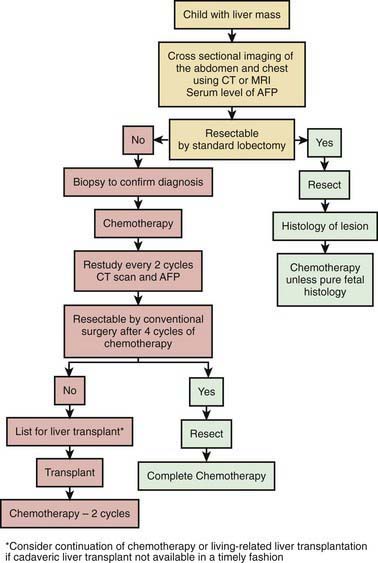Chapter 498 Neoplasms of the Liver
Hepatoblastoma
Treatment
In general, the cure of malignant hepatic tumors in children depends on complete resection of the primary tumor (Fig. 498-1). As much as 85% of the liver can be resected, with hepatic regeneration noted within 3-4 mo after surgery. Cisplatin in combination with vincristine and 5-fluorouracil or doxorubicin is effective treatment for hepatoblastoma and increases the chances of cure after complete surgical resection. In low-stage tumors, survival rates >90% can be achieved with multimodal treatment, including surgery and adjuvant chemotherapy. With tumors unresectable at diagnosis, survival rates of approximately 60% can be obtained. Metastatic disease further reduces survival, but complete regression of disease often can be obtained with chemotherapy and surgical resection of the primary tumor and isolated pulmonary metastatic disease, resulting in survival rates of about 25%. Liver transplant is a viable option for unresectable primary hepatic malignancies and results in good long-term survival. Pretransplant medical condition is an important predictor of outcome, and thus transplant is much more effective as the primary surgery than as salvage therapy.

Figure 498-1 Algorithm for the management of a child who presents with a hepatoblastoma. AFP, α-fetoprotein.
(From Tiao GM, Bobey N, Allen S, et al: The current management of hepatoblastoma: a combination of chemotherapy, conventional resection, and liver transplantation, J Pediatr 146:204–211, 2005.)
Austin MT, Leys CM, Feurer ID, et al. Liver transplantation for childhood hepatic malignancy: a review of the United Network for Organ Sharing (UNOS) database. J Pediatr Surg. 2006;41:182-186.
Litten JB, Tomlinson GE. Liver tumors in children. Oncologist. 2008;13:812-820.
Llovet JM, Burroughs A, Bruix J. Hepatocellular carcinoma. Lancet. 2003;362:1907-1916.
Perilongo G, Maibach R, Shafford E, et al. Cisplatin versus cisplatin plus doxorubicin for standard-risk hepatoblastoma. N Engl J Med. 2009;361:1662-1670.
Tiao GM, Bobey N, Allen S, et al. The current management of hepatoblastoma: a combination of chemotherapy, conventional resection, and liver transplantation. J Pediatr. 2005;146:204-211.






